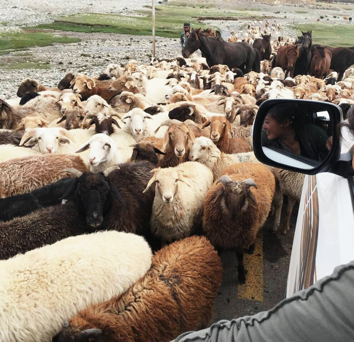Penn Museum Blog
Every year, the Penn Museum provides support to Penn undergraduates and graduate students as they deepen their understanding of the human experience outside the Museum’s walls. Follow these blog posts from our intrepid young scholars as they report on the sights and sites that they encounter throughout their travels in the field.
August 23, 2015
The guards patrolling on the border turn up in their puffy floor-length coats and greet us at the gates, the peaks in the distance coated in fresh snow; it must have been chilly in the night. They remove the barb-wired barricade and let our vehicles through. We spend almost 2 hours on the road daily, tottering down flooded paths and through sluggish herds. Up in the mountains, the weather changes drastically—when the sun gives way to thunderclouds, the gusty winds can chill to the bones. Occasionally we spend the night in yurts set up adjacent to the site; as night falls, we climb under layers of duvet, dressed head to toe, wishing we had a second skin.

Always give way to oncoming traffic!
At the moment I am writing, we are one week into the excavation of a stone slab grave, my second this season, but we have not yet located any material remains except for a goat/sheep scapula. Stone slabs less than 50 cm high outline the outermost perimeter, enclosing a circular stone arrangement that supposedly mark the mouth of the grave pit. We spend days on end troweling a sandy gravel and pebble mixture to observe differences in soil colors and textures that might indicate features of burial but there are few helpful pointers because sediments from different depositional events in this burial context can be very similar in this geographical area.
Previously, we spent two weeks locating the interment of another grave composed of stone slabs and stone clusters along with an anthropomorphic stone statue standing at a slant, but to no avail. The only artifact is also a scapula found in the western part of the enclosed area; if both graves prove to be empty, the scapula may serve as a vital clue to understanding a different type of funerary rite we have never encountered before in the area. These funerary slab structures are found in a large conglomeration of over 50 graves with the earliest dated to early 2nd millennium BCE. The graves we excavated in the previous seasons are all cists containing primary or secondary inhumation, or cremation. Contents of the graves, including ceramic pots, are typical of Central Asian Andronovo Bronze Age Culture.

Archaeology under the macro lens: can you outline the face of the statue?

Taking some aerial shots for 3D reconstruction.
The backdrop of my fieldwork is a vast morainic steppe landscape. Apart from stone architectural structures, we find figures of animals (sheep, goat, deer, etc.), humans and other geometric shapes etched on many of the megaliths. Some of these pieces of rock art are likely contemporaneous with the main habitation structure, as current excavation has yielded several antlers suggestive of ritualistic behavior associated with animals and zoomorphism.

Landscape and rock art
Because Xinjiang time is set at two hours ahead of its time zone, the days are long in the summer. But in the field, the hours seem short, especially in the company of teammates with whom I have worked for more than two seasons. These Mongol and Kazakh workmen come from nearby villages, spend their days around sheep and cattle, horses and camels; and they shoulder the most strenuous work at the site–building yurts, latrines, shoveling, and piling pounds of dirt into a neat ramp. They often provide the most accurate weather forecast, almost to the hour. Each year, I look forward to our reunion where they’d call me by the Mongol name they gave me and ask me where I have traveled in the past year. To them, the ‘outside’ world is a place of wonder.
One of the best moments of the day is when we gather around the kitchen table inside our tent after lunch for a traditional milk tea brewed with fresh milk fetched daily from the local pastoralists. I often volunteer to pick up the milk for the opportunity to be fed cheese freshly dried in the sun. When you are ever invited to a Kazakh’s home, you can almost never leave without eating something, which in a full meal may involve trying some rare ‘delicacies’ (such as lamb testicles)!

Kazakh hospitality

Fresh cheese drying in the sun
Photo Credits: Author
Posted in Students in the Field Tagged entral Asian Andronovo Bronze Age Culture, Kazakh, megaliths, Mongol, Xinjiang Leave a comment
1 comment:
Oh oh oh cooool!!! I love this! Thank you for sharing this blog!!Great article with excellent idea! I appreciate your post. Thanks so much and let keep on sharing your stuffs keep it up.
Granites in India
Post a Comment